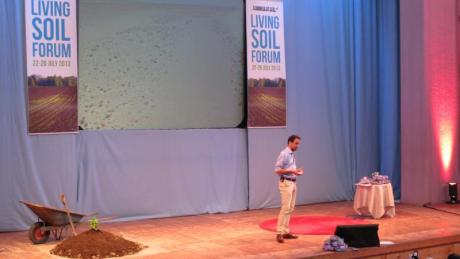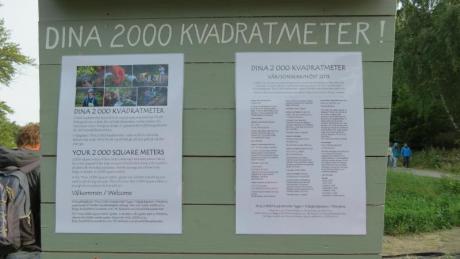On the third day of the forum, someone has been mentioning ’the FOMO syndrome’ (Fear Of Missing Out), and I have personally felt it as simultaneous action-oriented workshops are going on while I’m updating the webpage from a weak wi-fi connection in the café.
This day’s theme is called “Dreaming what is possible”, meaning that the discussion topics and good practice examples of yesterday are being translated into next steps for future activities. For this, 14 different ’design for wiser action’ sessions have been called (again, by the participants themselves). These will be the main forum activity until their results are presented by the end of Thursday, and are meant to create the very output of this week – setting up practical cooperation and projects that will last and continue after the forum.
So, as intriguing as these may be, we will wait until later with commenting on them, and I’ll focus today’s post on the greatly inspirational keynote presentations that were held in the morning: (Please scroll down to whatever you find interesting!)
Keynote I – A story of retail transparency
Michael Wilde from the Dutch organic food supplier Eosta presented how they as a middleman company can act to make a difference in agriculture around the world. He mentioned several projects and ideas that they are currently working with:
- Transparency as a key factor – The modern organic consumer expects their products to be not only organic but sustainable, and wish to know what impact it has. Nature and more has worked out the labelling system ’Nature and More’, where the consumers can use a code to read about the farmer of their specific product.
- Bees love organic – A campaign where the importance of pollination was communicated by consumer participation. 400.000 flower seed bags where supplied, encouraging customers to take active part in building ecosystem services through an aesthetically nice activity.
- Save our Soils – An information campaign together with organisations such as KRAV, WWF, and Sustainable Food Trust.
- Soilmate – Getting the message to the shelf through more communicative packaging.
Keynote II – Reversing desertification with biodynamic farming
Two speakers this day spoke on the issue of restoring barren land, and the first of these was Bijan Kafi of SEKEM. This farmers’ organisation has been working with biodynamic methods in Egypt for 35 years and have been able to expand into 700 ha of formerly unproductive land through composting, manure application and other agricultural methods with a long-term view.
There’s plenty we would have liked to ask, but unfortunately SIANI could not catch Bijan Kafi for an interview before he left. However, SEKEM’s activities seem to show a positive example of how soil ecosystems can not only be destroyed but also recreated.

Keynote III – What does it take to build a food movement?
The answer to this question seems to be “Not so much”, if you ask Pam Warhurst of the Incredible Edible Todmorden movement, which we also did today. With an urban and locally Brittish perspective, she is perhaps not of the greatest SIANI interest, but received the greatest round of applause this week for her heated presentation on how local food initiatives can be started. Initiatives such as small “free for all” public gardens and town maps marking green/local businesses can be done in any town, by any group of people who want to get things going.
Keynote IV – Large-scale ecosystem restoration
Last presenter John D. Liu (EEMP) has created acclaimed environmental films such as Green Gold (available online) but is also taking an active personal role towards action.
In his presentation, he showed how earlier human civilizations have eroded the natural capital of soils, and drew a parallel to how many soils are today becoming bereft of productivity in low-income countries. None the less, his documentation shows that ecosystems can be restored even on large-scale levels, if regards are paid to the basic physical conditions of soil: biodiversity, biomass, and accumulation of organic matter.
Liu has also been communicating through workshops and in personal discussion throughout the week, and formulates his messages with great emphasis:
- It is possible to do large-scale rehabilitation of damaged ecosystems
- There is money for doing this, from environmental funds through UNEP and others, but
- There is a lack of trained and active professionals to do this restoration
John Liu’s front message at this forum is his vision that an initiative will be created to establish Research, Training and Innovation Centres for Ecological Restoration around the world. A ’design for action’ working group on the theme was created in the afternoon, and is continuing its work in parallel with the other groups during Thursday.
Practical farming meeting a philosophical experiment: The 2000 m² farm
As we are right in the middle of a farming landscape, with some agricultural experiments going on, there are some field activities available to the forum participants. I’d like to end this post with describing one of them (also mentioned by Anneli in the Tuesday blog post): The 2000 m² farm.
This EU-funded farm plot experiment is taking its starting point in a theoretical concept: If all agricultural land on Earth was split between the population, we would have 2000 square meters each (plus some forest, pastures, lakes etc). The practical mission is to grow all the food a person needs in this limited space using ’ERA’ farming methods (that is, with organic nutrient recycling).
Apparently no-one is taking the experiment to the level of personally living from this farm only, but manager Ida-Johanna Carlander showed in brilliant clarity how for example 5½ m² where used to grow the ingredients for 12 pancakes (including animal fodder to supply for the milk; though she told us the space could ideally be squeezed down to 3½ m²).
In current Swedish practice, according to the managers, approximately 4000 m² are needed per person, and as much as 80% of Swedish farm land is used for animal feed (did I get this right?). The 2000 m² plot suggests a completely different set-up: grains and vegetables in good amounts, but meat on the table around once a week, as the grounds can give feed to only 1 sheep or 1/10 of a cow. Being a thought experiment (with perhaps an idealistic idea of nutrient recycling) this is still far from reality for most Western consumers, but is certainly something to ponder.
If you are in Sweden and wish to visit the 2000 m² farm in Järna, farming activities (closed-up with cooking from the farm plot!) are taking place Mondays-Thursdays 8.30-12.00, and special events take place about once per month. Check out their homepage, their blog, or their facebook page for more info, or contact the organisers directly at daniel@beras.eu and idajohanna@beras.eu.

Petter Nordqvist
SIANI